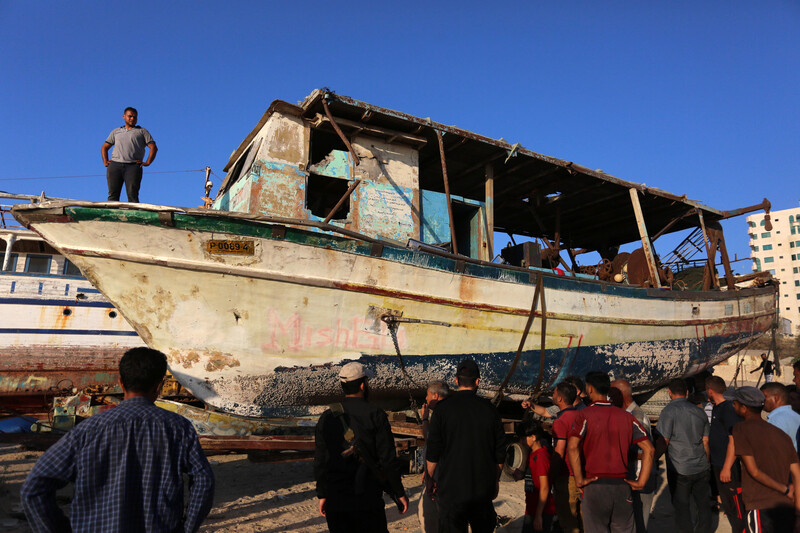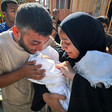Rights and Accountability 3 July 2019

Ishaq Ishteiwi (DCIP)
This week Israeli occupation authorities transferred the remains of a Palestinian boy killed by soldiers along Gaza’s southern boundary in April.
Ishaq Ishteiwi, 15, had crossed the perimeter fence east of Rafah to find work in Israel when he was shot and detained on 3 April, Defense for Children International Palestine had previously stated.
The teen was shot with live fire in the left shoulder, according to Al Mezan, a human rights group in Gaza. Another boy who was with Ishaq was shot in one of his legs. A third boy was uninjured.
All three boys were detained; the surviving teens were released the following day.
Israel is currently holding the bodies of 11 Palestinians from Gaza, including three children, killed since the launch of the Great March of Return protests on 30 March 2018.
Children intentionally shot
More than 200 Palestinians, including 44 children, have been killed by Israeli occupation forces during the regular protests along Gaza’s eastern and northern boundaries.
A UN commission of inquiry found that Israeli forces may have committed war crimes and crimes against humanity by using lethal military force against unarmed protesters in Gaza.
“[Israeli forces] have intentionally shot children, they’ve intentionally shot people with disabilities, they’ve intentionally shot journalists, knowing them to be children, people with disabilities and journalists,” Sara Hossain, one of the three investigators appointed by the UN Human Rights Council, said.
An additional 100 Palestinians were killed in Gaza by Israeli forces outside the context of protests during the same period.
Fifteen Palestinian children have died by Israeli fire so far this year, all but three of them in Gaza.
Fishing boat returned
On Monday, Israel returned to Gaza a fishing boat that it had seized and held for three years “without legal authority,” according to Gisha, one of three human rights groups that waged a legal battle to see its return.
“Before it was seized, the boat employed no less than 24 fishermen,” Gisha stated.The ship was badly damaged when it was seized and during the time it was held without maintenance, to the point where it could not be returned by sea, the rights group added. “Its owner estimates that repairing it will cost over $45,000.”

A fishing boat returned to Gaza by Israel three years after it was confiscated, Gaza City, 1 July.
APA imagesIsrael’s severe restrictions on the import of items such as motor parts, machinery and fiberglass into Gaza means that the materials needed to repair the ship are not available in the territory, according to Al Mezan.
Israel returned 20 more boats by sea on Wednesday, though fishers reported that the motors and fishing equipment appeared to be missing from the vessels.
Israel said that it would return dozens more boats seized from Gaza fishers within four months.“Israel routinely seizes boats from fishermen in Gaza and holds them for months, even years, without legal authority and in violation of international law,” Gisha stated.
“This punitive and illegal measure causes severe harm to the fishing industry and to Gaza’s economy, and must be stopped.”
Fishers under attack
Last month, Israel imposed a week-long maritime closure of Gaza’s coastal waters. The total prohibition on Gaza fishers from working their trade was a collective punishment measure imposed due to incendiary balloons and kites launched from the territory.
So far this year, Israeli forces have fired on Gaza fishers more than 200 times, injuring 15. Some 30 fishers have been detained and 11 boats confiscated, according to Al Mezan.
Under the Oslo accords signed by Israel and the Palestine Liberation Organization more than 25 years ago, Palestinian fishers are permitted access up to 20 nautical miles out from Gaza’s coast.
Israel has never allowed Palestinians access beyond 15 nautical miles, however, and that expanded limit was only introduced for part of Gaza’s coast on 1 April this year.
Fish caught off Gaza’s coastal waters are a major source of nutrition for Palestinians in the territory, though one that fewer and fewer can afford.
Massacre commander promoted
Ofer Winter, a military commander who exhorted his troops to holy war and oversaw a massacre of civilians during Israel’s 2014 Gaza onslaught, has been rewarded with a promotion.
So many civilians were killed during the Black Friday massacre commanded by Winter, filling hospital morgues to capacity, that the bodies of small children were stored in vegetable coolers and ice cream freezers until they could be buried.
Between 135 to more than 200 Palestinian civilians were killed, including 75 children, during the massacre in Rafah, southern Gaza.
An investigation by Amnesty International and Forensic Architecture found “strong evidence” that Israeli troops had carried out war crimes in their attempt to kill a captured soldier under the Hannibal directive and as revenge for his capture.





